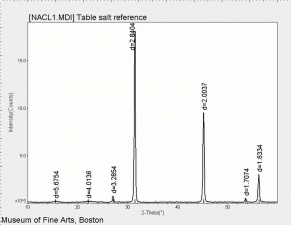Difference between revisions of "Sodium chloride"
m (Text replace - "== Authority ==" to "== Sources Checked for Data in Record ==") |
m (Text replace - "\[http:\/\/cameo\.mfa\.org\/materials\/fullrecord\.asp\?name=([^\s]+)\s(.*)\]" to "$2") |
||
| Line 1: | Line 1: | ||
== Description == | == Description == | ||
| − | Colorless, cubic crystals that naturally occur in ocean water at concentrations of 2.6% and as the mineral halite. Sodium chloride is obtained by evaporation of brines (sea salt) and by mining underground and surface deposits of halite (rock salt). Sodium chloride is widely used in food products for flavoring and preservation (see [ | + | Colorless, cubic crystals that naturally occur in ocean water at concentrations of 2.6% and as the mineral halite. Sodium chloride is obtained by evaporation of brines (sea salt) and by mining underground and surface deposits of halite (rock salt). Sodium chloride is widely used in food products for flavoring and preservation (see [[table%20salt|table salt]]). It is used for curing hides and skins prior to transportation or storage. Sodium chloride is also used in electrochemical reactions and as an assistant in mordanting. In a closed environment, a saturated solution of sodium chloride will maintain a relative humidity of about 75% (20C). In photography, sodium chloride is used in the precipitation of photographic emulsions, in reducing and toning solutions and as a washing aid to eliminate residual thiosulfate from silver images. |
== Synonyms and Related Terms == | == Synonyms and Related Terms == | ||
| Line 13: | Line 13: | ||
Soluble in water, glycerol. Slightly soluble in ethanol. Crystal system is isometric with cubic cleavage. | Soluble in water, glycerol. Slightly soluble in ethanol. Crystal system is isometric with cubic cleavage. | ||
| − | Deliquescent point at 20C is 75.5 % RH (see [ | + | Deliquescent point at 20C is 75.5 % RH (see [[saturated%20salt%20solutions|saturated salt solutions]]) |
{| class="wikitable" | {| class="wikitable" | ||
Revision as of 12:17, 10 May 2016
Description
Colorless, cubic crystals that naturally occur in ocean water at concentrations of 2.6% and as the mineral halite. Sodium chloride is obtained by evaporation of brines (sea salt) and by mining underground and surface deposits of halite (rock salt). Sodium chloride is widely used in food products for flavoring and preservation (see Table salt). It is used for curing hides and skins prior to transportation or storage. Sodium chloride is also used in electrochemical reactions and as an assistant in mordanting. In a closed environment, a saturated solution of sodium chloride will maintain a relative humidity of about 75% (20C). In photography, sodium chloride is used in the precipitation of photographic emulsions, in reducing and toning solutions and as a washing aid to eliminate residual thiosulfate from silver images.
Synonyms and Related Terms
salt; table salt; sea salt; halite; rock salt; muriate of soda; bay salt; solar salt; common salt
Other Properties
Soluble in water, glycerol. Slightly soluble in ethanol. Crystal system is isometric with cubic cleavage.
Deliquescent point at 20C is 75.5 % RH (see Saturated salt solutions)
| Composition | NaCl |
|---|---|
| CAS | 7647-14-5 |
| Melting Point | 801-804 |
| Density | 2.165 |
| Molecular Weight | mol. wt. = 58.4 |
| Boiling Point | 1413 |
Hazards and Safety
Noncombustible. Can induce rusting of steel and iron. Corrosive to zinc.
Mallinckrodt Baker: MSDS
Sources Checked for Data in Record
- G.S.Brady, Materials Handbook, McGraw-Hill Book Co., New York, 1971 Comment: p. 685
- Richard S. Lewis, Hawley's Condensed Chemical Dictionary, Van Nostrand Reinhold, New York, 10th ed., 1993
- Van Nostrand's Scientific Encyclopedia, Douglas M. Considine (ed.), Van Nostrand Reinhold, New York, 1976
- Random House, Webster's Encyclopedic Unabridged Dictionary of the English Language, Grammercy Book, New York, 1997
- The Merck Index, Martha Windholz (ed.), Merck Research Labs, Rahway NJ, 10th edition, 1983 Comment: entry 8742
- The American Heritage Dictionary or Encarta, via Microsoft Bookshelf 98, Microsoft Corp., 1998
- The Dictionary of Paper, American Paper Institute, New York, Fourth Edition, 1980
- Matt Roberts, Don Etherington, Bookbinding and the Conservation of Books: a Dictionary of Descriptive Terminology, U.S. Government Printing Office, Washington DC, 1982
- Susan E. Schur, Conservation Terminology: A review of Past & Current Nomenclature of Materials, Technology and Conservation, Spring (p.34-39); Summer (p.35-38); Fall (p.25-36), 1985
- John and Margaret Cannon, Dye Plants and Dyeing, Herbert Press, London, 1994
- Website address 1 Comment: www.jetcity.com/~mrjones/chemdesc.htm - photographic chemicals

